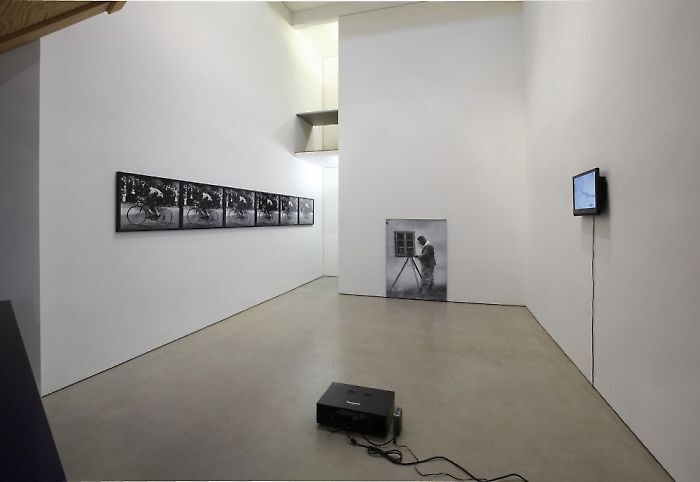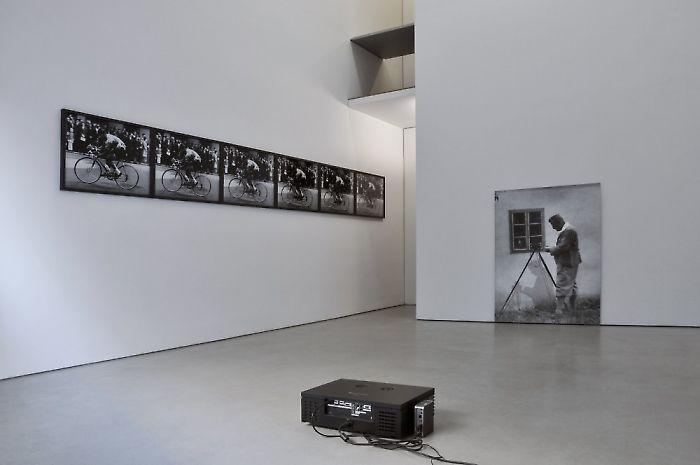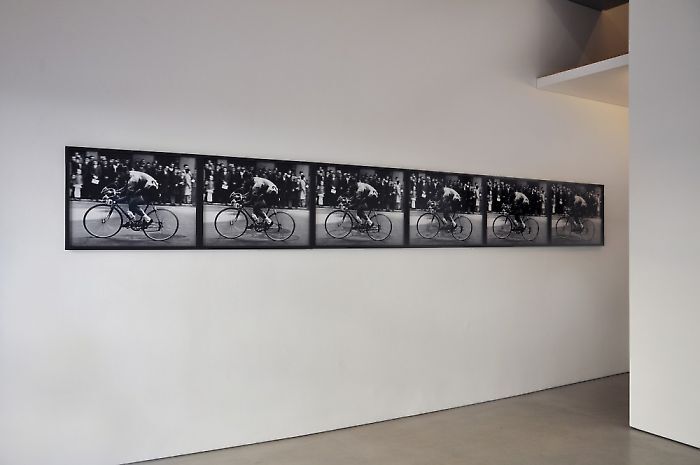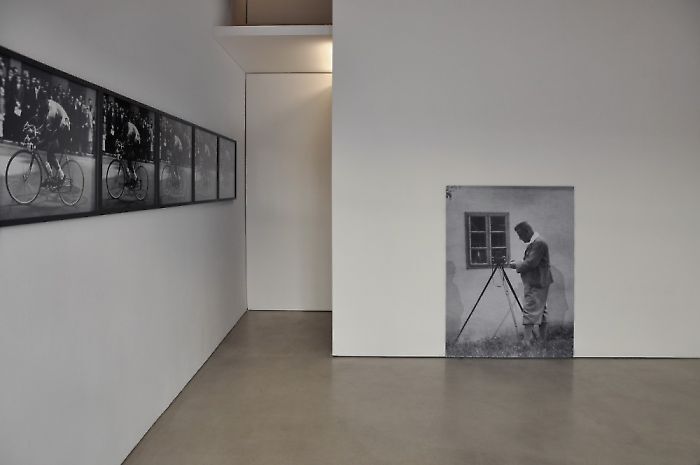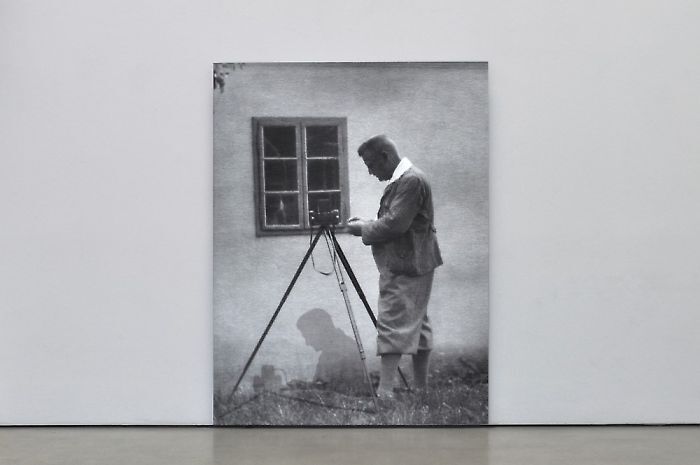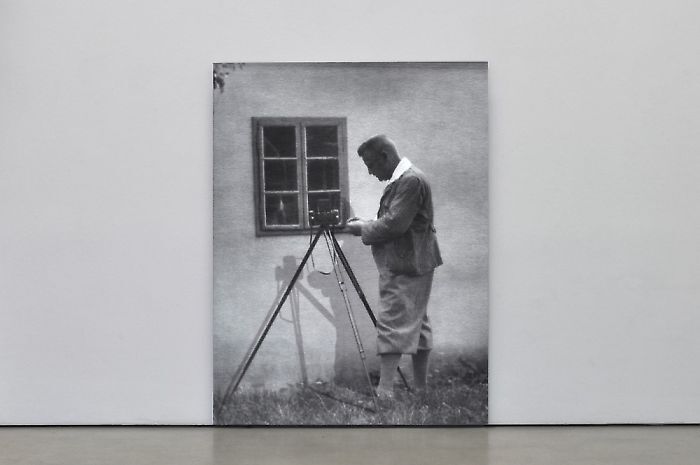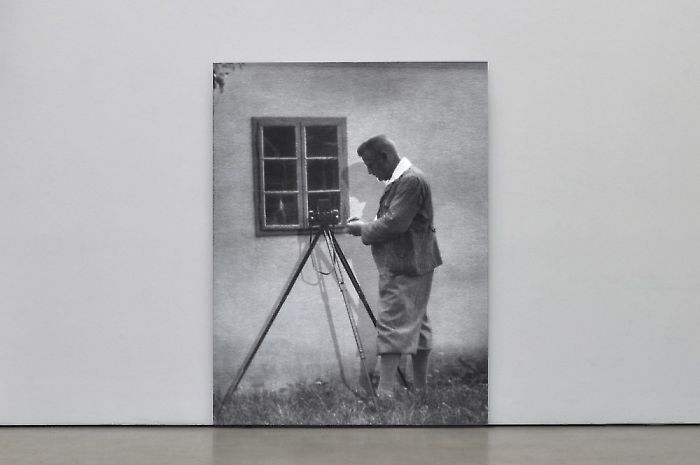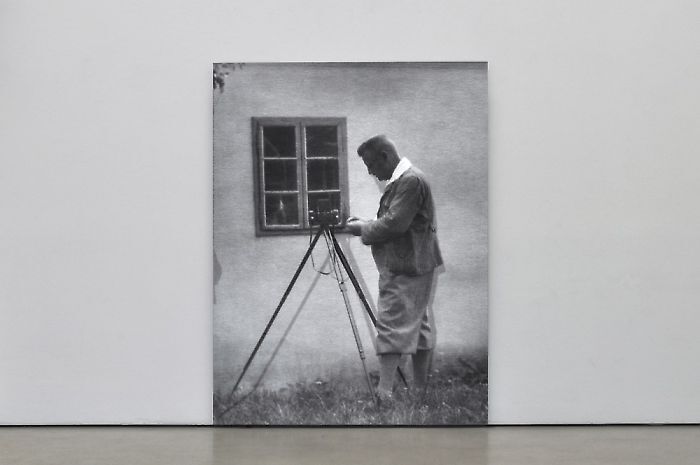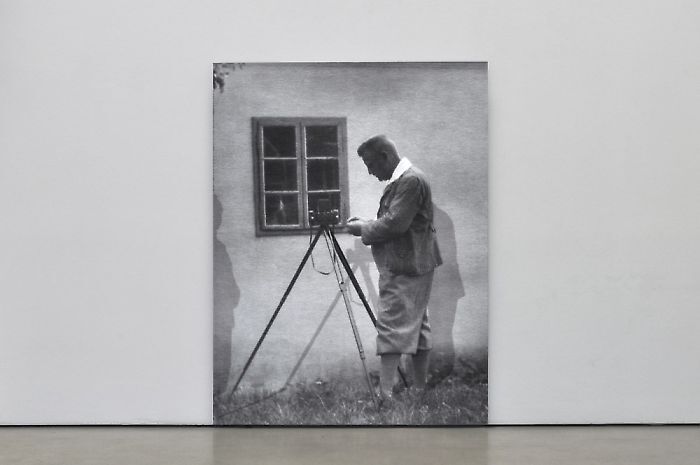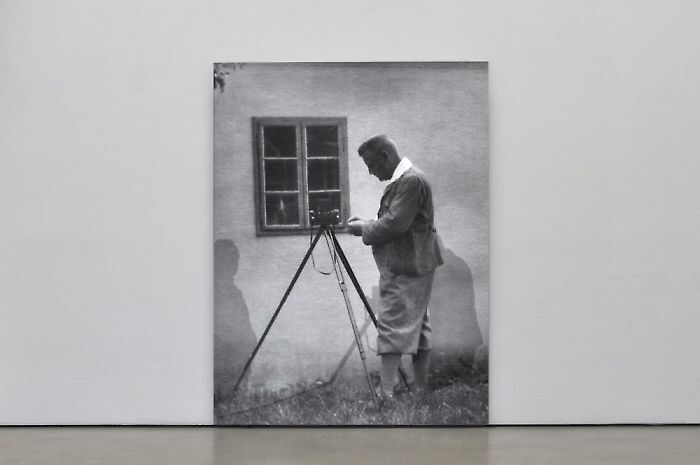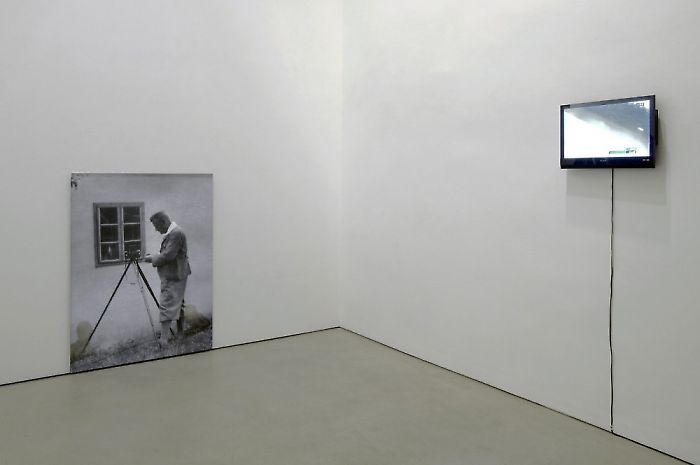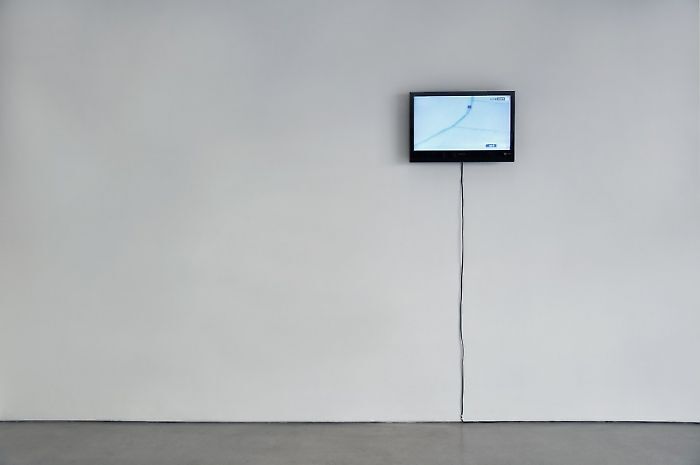—
Liddy Scheffknecht
a moving standstill
Liddy Scheffknecht’s Media Hybrids
When it comes to photography, movement and standstill are two characteristics that are usually treated as a contradiction. As a cut through space and time, the photographic medium not only arrests a moment, it also stages that moment in an image, statically and enduringly. Photography “embalms time”: with this—still today one of the most famous descriptions of the phenomenon—André Bazin sought to understand its distinction from a different medium: film. Film goes beyond photography, for it adds the very element that defines the limits of photography: the definition of a temporal sequence by way of movement.
On first glance, Liddy Scheffknecht’s work 7 Minutes 13 Seconds clearly corresponds to the characteristics of photography: static, immobile, and staged in an enduring fashion, a photographer operates before the outside wall of a building on the shutter release button of a stereo camera placed on a tripod. The photograph was not taken by the artist herself, but is a visual product made by an anonymous photographer that Scheffknecht appropriated, enlarged, and recontextualized. The discursive strategy of media appropriation serves to visualize the aforementioned differences between photography and film. This is made concretely visible in an elementary motif: the video of a shadow is precisely projected onto the photograph, and the referent of this shadow seems to be the photographer depicted. In so doing, the shadow reveals an important characteristic that goes beyond the photographic medium: movement. It slowly moves across the image and by way of its changing shape not only visualizes a temporal sequence, but also mixes photography and film. In this superimposition of two visual levels, Scheffknecht generates a media hybrid, whereby the limits separating the two media are both violated and visualized as transparent. Accordingly, the semantics of the image need to be sought in the difference between the two media.
This complex relationship is explored in a similar way in Scheffknecht’s 6 Minutes 38 Seconds. This series of photographs shows a bicyclist whose dynamic motion is suggested by the blurry audience in the background, while the cyclist himself seems focused, like a statue at the center of the picture. The temporally punctual shot of the cyclist, torn from a movement in a fragment of a second and fixed, is repeated in all the photographs of the series. The series of pictures—which itself is a well-known stylistic device to suggest temporal change and thus (filmic) movement across a series of images—thus seems ambivalent. It is not the bicyclist that changes position, but the apparently secondary visual motif of the shadow. In contrast to the depiction [BC1] of the sportsman, the cyclist can be found in each of the images in a different form, thus evoking continuous movement. The contrast between statics and the changed form of a shadow highlights a “break” and/or a “difference” between the two visual layers, which in turn generates a media hybrid of photography and film. Beyond the aspect of media theory, the shadow can also be defined as an elementary stylistic device, which is also illustrated by 7 Minutes 13 Seconds.
The dialectic between static and movement is underscored in the video projection onto the photograph by divorcing the shadow from its referent and/or the photographer. On first glance, its continuously changing shape seems not to be an “imprint” or the result of the photographer, but rather suggests an invisible light source. On closer examination, this proves to be an illusion: the shape of the shadow can thus not be explained as a logical visual transformation, but due to its autonomous form the shadow separates itself from the causality of its reference, and thus emerges as an independent “double”. As the only mobile element, it dominates the statistic elements and divorces itself from the narrative context.
The photograph’s proximity to reality as well as the course of the shadow, which initially appears to be logical, yet ultimately cannot be traced back to the photographer, makes Scheffknecht’s work slip into the uncanny-surreal.
By way of conclusion, if a silhouette appears in Scheffknecht’s picture that no longer possesses any referent in the photograph itself, it includes an additional authority addressed by the camera of the photographer: the viewer. As a perceiving authority, he or she is thus inscribed as the midpoint between model and depiction, reproduction and construction, just as between photographic “reality” and its restaging in film.
Text: Walter Moser
Translation: Brian Currid
Biography
born 1980 in Dornbirn/AT; lives and works in Vienna
Selected Solo Exhibitions
2025
Mapping Time, Atelier Haaskeusche, Glanegg
Living Room (Closing), ORF-Landesfunkhaus, Vorarlberg
2023
Broken Flowers, korridor, Vienna
2021
nine to five, Kunstraum Weikendorf, Weikendorf
2020
Dimensions, Sehsaal, Vienna
pictorial space, Schauraum Quartier21, Vienna
2018
points in time, Georg Kargl BOX, Vienna
mirage, Galerie Lisi Hämmerle, Bregenz
2016
dream argument, Kunsthalle Nexus, Saalfelden
Solar days, Remise Bludenz, Bludenz
sciography, Georg Kargl Fine Arts, Vienna
2015
shift, Galerie der Stadt Wels, Wels
2013
spot, Sotheby’s Artist Quarterly, Vienna
2012
eleven minutes twenty seconds, Kunsthaus Graz, Graz
sence, Ex-Garage, Maribor
2011
LIDDY SCHEFFKNECHT, Georg Kargl BOX, Vienna
Bubblegums, The Outside Gallery Window, Milan
2008
Take Aways, Galerie Wilma Lock, St. Gallen
whiteout, Galerie Jeune Création, Paris
2006
scaffoldings, The Outside Gallery Window, Milan
Selected Group Exhibitions
2026
Not Nice Girls! - The female view in photographies from the SpallArt Collection, Galerie im Alten Rathaus, Prien am Chiemsee
2025
In the Lights of Shadows, Forum für Fotografie, Cologne
Learning Systems, Vienna Art Week, Vienna
FASCINATION PAPER - Rembrandt to Kiefer, Albertina, Vienna
2022
The Fest, MAK, Vienna
2021
Heimspiel, Kunstraum Dornbirn, Dornbirn
25 Jahre Kunstforum Montafon, Kunstforum Montafon, Vorarlberg
Sammlung König-Lebschik,KUB Sammlungsschaufenster, Bregenz
Auf eigene Gefahr, Vorarlberg Museum, Bregenz
Solar Habitat, Lindabrunn
Unerkannnt, Bekannt, Kunstmuseum Appenzell, Appenzell
2021
Heimspiel, Kunstraum Dornbirn, Dornbirn
25 Jahre Kunstforum Montafon, Kunstforum Montafon, Vorarlberg
Auf eigene Gefahr, Vorarlberg Museum, Bregenz
Unerkannnt, Bekannt, Kunstmuseum Appenzell, Appenzell
2020
Would You Be Available…, Georg Kargl Permanent, Vienna
Borderland, Fotogalerie Wien, Vienna
Attempt at Rapprochement, Georg Kargl Fine Arts, Vienna
fake & fragment, Sehsaal, Vienna
Now. Collected #9/#10, Bank Austria Kunstforum, Vienna
minus 20 degrees, Festival for Art and Architecture, Flachau
2018
Plinque Projéction II, Cité Internationale des Arts Paris, Paris
Heimspiel 2018, Kunstmuseum Appenzell, Appenzell
A Recollection of Resonances, bb15’s 10-Year Anniversary Exhibition, bb15 - Raum für Gegenwartskunst, Linz
CONCENTRATION - a tribute, Gesellschaft für projektive Ästhetik, Georg Kargl, Vienna
Reduction, Gesellschaft für Projektive Ästhetik, Georg Kargl, Vienna
2017
Plex Noir, Atelier Van Lieshout, Atisuffix, Manfred Erjautz, Werner Reiterer, Liddy Scheffknecht, Johannes Vogl, Kunst im öffentlichen Raum, Graz
2016
dream argument, Kunsthalle Nexus, curated by Petra Noll
Hybrid (...) Scapes, Nida Art Colony, Nida (Lithuania)
FILTER, Kunstforum Montafon, Schruns, curated by Verena Kaspar-Eisert
2015
Transparency, Georg Kargl Fine Arts, Vienna, curated by Fiona Liewehr
Landscape: Transformations of an Idea – Art of the 1800 to the Present day from the Collection of the Neue Galerie Graz, Neue Galerie Graz, curated by Gudrun Danzer and Günther Holler-Schuster
Random thoughts of a daily light, das weisse haus, Vienna, curated by Alexandra Grausam und Markus Taxacher
Schneesalon, Georg Kargl BOX, Vienna
(O)budowa, Liddy Scheffknecht, Jan Mioduszewski, Austrian Cultural Forum Warsaw, Warsaw, curated by Jacek Malinowski
2014
Blow-Up, Albertina, Vienna, curated by Walter Moser
côte intérieur, Kunstpavillon, Innsbruck, curated by Ingeborg Erhart und Bernd Oppl
Inattentional Blindness, Galerie Zilberman, Istanbul, curated by Isin Önol
2013
Phantoms & Ghosts, das weisse haus, Wien, curated by Karin Fisslthaler und Bernd Oppl
The Intransigent Ticket - The Artist as a Filter, CSULA Fine Arts Gallery, Los Angeles, curated by Karin Mayr & Martin Sturm
PLI SELON PLI, Galerie 22,48m², Paris, curated by Yvonne Rüscher
ELASTIC VIDEO, Kunstraum Niederösterreich, Vienna, curated by PLINQUE
2012
/TILT/, Liddy Scheffknecht, Armin B. Wagner, Zentralkunstgarage, Lustenau
Parcours, Claudia Larcher/ Liddy Scheffknecht, Galerie Stephanie Hollenstein Lustenau, curated by Winfried Nussbaummüller
4. Internationale Sinop Biennale, curated by Isin Önol, Sinop, Turkey, curated by Isin Önol
Genius loci, Kulturpolis, Klaipéda, Lithuania, curated by Yulia Startseva and Vytautas Michelkevicius
The Digital Uncanny, Edith – Ruß – Haus for Media Art, Oldenburg, curated by Brigitte Felderer
2011
This is Happening II, Georg Kargl Fine Arts, Vienna, curated by Fiona Liewehr
Donetsk goes Contemporary, Art Point Donetsk, Ukraine, curated by Andrei Loginov and Steve Schepens
Space Odyssey, März / Linz, curated by Bernd Oppl
Meet everyone at once, start an artist-run-space, Ogms, Sofia
Kaleidoskop, In der Kubatur des Kabinetts - der kunstsalon im fluc, Fluc, Vienna
Elastic Video, Tokyo Wonder Site Hongo, Tokyo, curated by PLINQUE
2010
HAPPY HOUR, In der Kubatur des Kabinetts - der kunstsalon im fluc, Fluc, Vienna
Qui vive, 2nd Moscow International Biennale for Young Art, Artplay Design Center, Moscow
Mathias Garnitschnig, Claudia Larcher, Liddy Scheffknecht, c.art, Dornbirn, curated by Gerold Tagwerker
Austria la vista, baby, The Art Foundation, Athens
Petit Plinque, Transforming Freedom, Museumquartier, Vienna
Fine Line, Georg Kargl Fine Arts, Vienna, curated by Fiona Liewehr
Bernd Oppl, Liddy Scheffknecht, bb 15 / Linz
WIR WOHNEN, Kunstraum Niederösterreich, Vienna
2009
Plinque Projéction, Cité Internationale des Arts, Paris, curated by PLINQUE
Biennale of Young Artists of Europe and the Mediterranean, Nacionalna Galerija - Mala Stanica, Skopje
Plinque Meringue, Contemporary, Vienna
UnOrtnung V, Ankerbrotfabrik, Vienna
2008
Jeune Création 2008, Parc de la Villette, Espace Charlie Parker, Paris
GAMES. Kunst und Politik der Spiele, Kunsthalle Vienna project space, Vienna
Inquiry
Please leave your message below.
